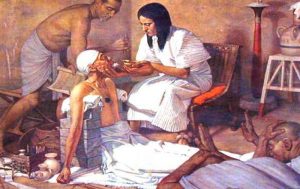In Egyptian Health modern medicine owes much to the Ancient Egyptians. Most famous of the Egyptian physicians is Imhotep, who is also renowned for his role as a Pyramid designer. Physicians such as Imhotep used a variety of methods to heal patients but based much of their practice upon religious belief: physicians in Ancient Egypt were also priests.
It was common for different priests to act as physicians for different parts of the body, in much the same way that doctors specialize now, as they believed that different gods governed different sectors of the human body.

Medicine of ancient Egyptians was very advanced. They performed different surgeries. By doing a dissection of mummies, they gained knowledge of anatomy. The surgeries they performed were very interesting. They knew how to successfully amputate body parts, circumcision, catheterization, stop bleeding by compression, and even brain surgery. An ointment was used as an anesthesia for these surgeries.
Study of Egyptian Disease
The academic study of Egyptian disease can be divided into three distinct categories. The first is the study of medical Papyri. The second is the study of the artistic representation of disease in the Nile Valley. The third, and perhaps most obvious, is the study of human remains, both skeletal and soft tissue, of ancient Egyptians.
The ancient mummies show a history of serious dental problems. The mummies battled periodontal diseases, abscesses, cavities, and worn teeth. It was concluded that the culture was plagued with a variety of dental diseases. The researchers came across degenerative disorders, large numbers of osteoarthritis cases, and mummies who had succumbed to atherosclerosis – a hardening of the arteries.
Egyptian Health Researchers
Researchers have found some diseases prevalent in ancient Egypt. Dwarfism is one of these. The majority of dwarfs were achondroplastic, a form resulting in a head and trunk of normal size with shortened limbs. There are several historic Egyptian representations which indicate the possibility of tuberculosis deformity.
Sometimes ancient Egyptians took in guinea worms in their drinking water. The female guinea worm would travel to its preferred site – the host’s legs – in order to lay her eggs, again causing ill Egyptian Health. But ancient Egyptians took careful measures during childbirth. The 18th Dynasty Ebers Medical Papyrus included a useful section dealing with women’s health, concentrating on such all-important maters as conception, pregnancy, and breastfeeding.